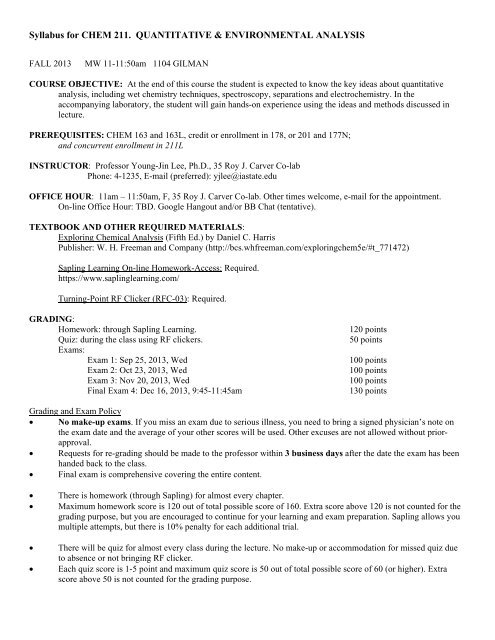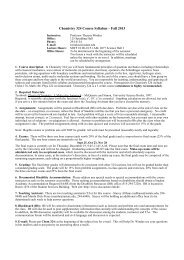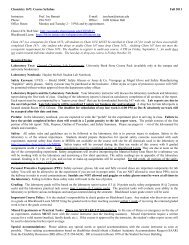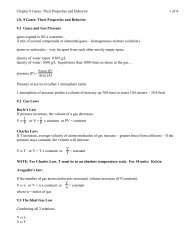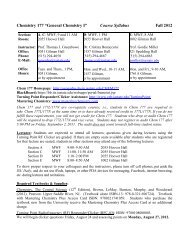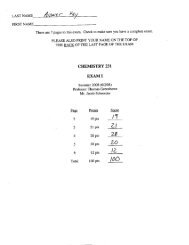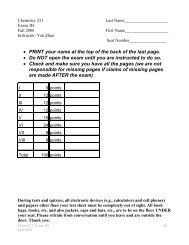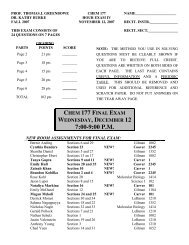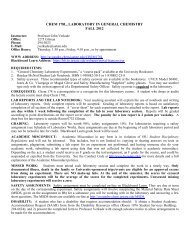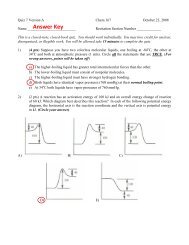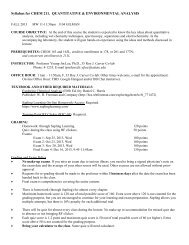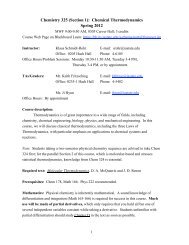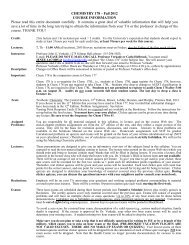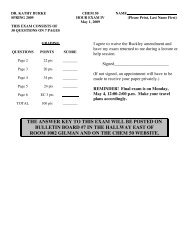Syllabus for CHEM 211. QUANTITATIVE & ENVIRONMENTAL ...
Syllabus for CHEM 211. QUANTITATIVE & ENVIRONMENTAL ...
Syllabus for CHEM 211. QUANTITATIVE & ENVIRONMENTAL ...
You also want an ePaper? Increase the reach of your titles
YUMPU automatically turns print PDFs into web optimized ePapers that Google loves.
<strong>Syllabus</strong> <strong>for</strong> <strong>CHEM</strong> <strong>211.</strong> <strong>QUANTITATIVE</strong> & <strong>ENVIRONMENTAL</strong> ANALYSISFALL 2013MW 11-11:50am 1104 GILMANCOURSE OBJECTIVE: At the end of this course the student is expected to know the key ideas about quantitativeanalysis, including wet chemistry techniques, spectroscopy, separations and electrochemistry. In theaccompanying laboratory, the student will gain hands-on experience using the ideas and methods discussed inlecture.PREREQUISITES: <strong>CHEM</strong> 163 and 163L, credit or enrollment in 178, or 201 and 177N;and concurrent enrollment in 211LINSTRUCTOR: Professor Young-Jin Lee, Ph.D., 35 Roy J. Carver Co-labPhone: 4-1235, E-mail (preferred): yjlee@iastate.eduOFFICE HOUR: 11am – 11:50am, F, 35 Roy J. Carver Co-lab. Other times welcome, e-mail <strong>for</strong> the appointment.On-line Office Hour: TBD. Google Hangout and/or BB Chat (tentative).TEXTBOOK AND OTHER REQUIRED MATERIALS:Exploring Chemical Analysis (Fifth Ed.) by Daniel C. HarrisPublisher: W. H. Freeman and Company (http://bcs.whfreeman.com/exploringchem5e/#t_771472)Sapling Learning On-line Homework-Access: Required.https://www.saplinglearning.com/Turning-Point RF Clicker (RFC-03): Required.GRADING:Homework: through Sapling Learning.Quiz: during the class using RF clickers.Exams:Exam 1: Sep 25, 2013, WedExam 2: Oct 23, 2013, WedExam 3: Nov 20, 2013, WedFinal Exam 4: Dec 16, 2013, 9:45-11:45am120 points50 points100 points100 points100 points130 pointsGrading and Exam Policy No make-up exams. If you miss an exam due to serious illness, you need to bring a signed physician’s note onthe exam date and the average of your other scores will be used. Other excuses are not allowed without priorapproval. Requests <strong>for</strong> re-grading should be made to the professor within 3 business days after the date the exam has beenhanded back to the class. Final exam is comprehensive covering the entire content.There is homework (through Sapling) <strong>for</strong> almost every chapter.Maximum homework score is 120 out of total possible score of 160. Extra score above 120 is not counted <strong>for</strong> thegrading purpose, but you are encouraged to continue <strong>for</strong> your learning and exam preparation. Sapling allows youmultiple attempts, but there is 10% penalty <strong>for</strong> each additional trial.There will be quiz <strong>for</strong> almost every class during the lecture. No make-up or accommodation <strong>for</strong> missed quiz dueto absence or not bringing RF clicker.Each quiz score is 1-5 point and maximum quiz score is 50 out of total possible score of 60 (or higher). Extrascore above 50 is not counted <strong>for</strong> the grading purpose.
<strong>Syllabus</strong> <strong>for</strong> <strong>CHEM</strong> <strong>211.</strong> <strong>QUANTITATIVE</strong> & <strong>ENVIRONMENTAL</strong> ANALYSISOther notes: Read Chapter 2 be<strong>for</strong>e per<strong>for</strong>ming your first Chemistry 211L laboratory experiment. The instructor reserves the right to make changes to the syllabus and schedule and will notify students of thosechanges in lecture. Students are expected to follow the standards set <strong>for</strong>th by the ISU Dean of Students:http://www.dso.iastate.edu/ja/academic/students.html. All lecture notes and exam grades are available through Blackboard: https://bb.its.iastate.edu/ RF Clicker Assistance: http://www.celt.iastate.edu/elearning/?page_id=145 Students are expected to read the chapter be<strong>for</strong>e and/or right after the class. Attending lecture or reading lecturenotes does not replace reading the textbook. Relevant chapters in the textbook are indicated below. Telephones, pagers and other electronic devices that distract students or the instructor are not allowed in theclassroom unless they are turned off. Students creating disturbances that interfere with the conduct of the class or the learning of others will be asked toleave the lecture room. Ask questions any time. Expect up to 48 hours to respond to e-mail questions.ADA Compliance Statement: Please address any special needs or special accommodations with the course instructor asearly in the semester as possible. Those seeking accommodations based on disabilities should obtain a Student AcademicAccommodation Request (SAAR) from the Disability Resources (DR) office (515-294-6624). DR is located in Room1076 of the Student Services Building. Web site: http://www.dso.iastate.edu/dr/TENTATIVE CLASS SCHEDULE:Hone Work DUEAug 26 th <strong>Syllabus</strong>, and Chapter 0: Analytical Process Sep 2 nd28 th Chapter 1: Chemical Measurements Sep 4 thSep2 nd No class4 th Chapter 3 (3-5 optional): Math Toolkit Sep 11 th9 th Chapter 4 (4-4, 4-8 optional): Statistics Sep 16 th11 th /16 th Chapters 8: Acids & Bases Sep 23 rd18 th Chapter 9: Buffers Sep 25 th23 rd Chapters 6 (6-3 and 6-6 optional) and 13-1, 13-2: Titrations Sep 30 th25 th 1 st Exam, covers Ch. 0, 1, 3, 4, 8, 930 th Chapter 10 (10-7 optional): Acid Base TitrationsOct 2 nd Chapter 10 (10-7 optional): Acid Base Titrations Oct 9 th7 th /9 th Chapter 11: Polyprotic Acids & Bases Oct 16 th14 th Chapters 5 (5-1 optional): Instrumental Methods Introduction and Calibration Oct 21 st16 th Chapter 18: Spectroscopy Oct 23 rd21 st Chapter 19 (19-1 optional): Spectroscopy Instruments Oct 28 th23 rd 2 nd Exam, covers Ch. 6, 13 (parts), 10, 11, 5, 1828 th Chapters 20 and 21-4 & 21-5: Atomic Spectroscopy & Mass Spectrometry Nov 4 th30 th Chapter 21-1, 21-2 & 21-3: Chromatography Introduction Nov 6 thNov 4 th /6 th Chapter 22 (22-4 optional): Gas & Liquid Chromatography Nov 13 th11 th /13 th Chapter 23 (23-8 optional): Various Chromatography and Capillary Electrophoresis Nov 20 th18 th Chapter 14: Electrochemistry Introduction & Electrodes20 th 3 rd Exam, covers Chapters 19, 20, 21, 22, 2325 th /27 th Thanksgiving BreakDec 2 nd Chapter 14: Electrochemistry Dec 9 th4 th Chapter 15: Electrode Measurements Dec 11 th9 th Chapter 16-1: Redox Titration Dec 15 th11 th Chapter 17: Electrochemical Methods Dec 15 th16 th Final Exam (9:45-11:45am)


